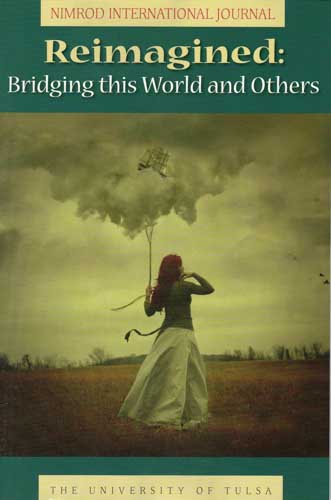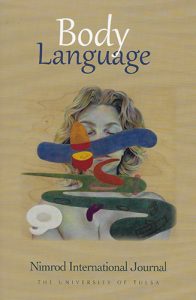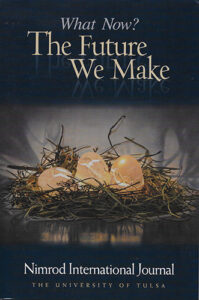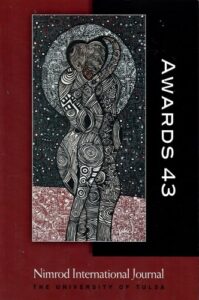Nimrod International Journal – Spring/Summer 2014
Stories build bridges in the human community, and this issue of Nimrod explores the rebuilding and re-purposing of many such bridges. As Eilis O’Neal points out in the editor’s note, the focus of this themed issue is work that reimagines “fairy tales, myths, historical events, and family legends, as well as work that reimagines voice, poetic form, art, and even language via translation.” Life reimagined in the presence of death, temporal and spatial reality reimagined in terms of various binaries, old tales adjusted to newer realities, language reconceived with fresh nuances, all this and more is here. Stories build bridges in the human community, and this issue of Nimrod explores the rebuilding and re-purposing of many such bridges. As Eilis O’Neal points out in the editor’s note, the focus of this themed issue is work that reimagines “fairy tales, myths, historical events, and family legends, as well as work that reimagines voice, poetic form, art, and even language via translation.” Life reimagined in the presence of death, temporal and spatial reality reimagined in terms of various binaries, old tales adjusted to newer realities, language reconceived with fresh nuances, all this and more is here.
The issue begins wittily in the happily ever-after of once upon a time with Joan Roberta Ryan’s poem, “Sequel,” written as a letter to the handsome prince, now king, from that lucky Cinderella he chose as his bride: “I’m writing to you because I’m afraid / someone is rewriting our story.” There follow several poems that re-examine language with an eye to reinterpreting how we name and conceptualize, and thus how we form stories, as in Zeina Hashem Beck’s “Rewriting Beyrouth.” Speaking of the word Beyrouth itself, she says, “To write you down is like writing with rain, with thirst. / To spell you is always / a spell gone wrong.”
In Walter Cannon’s “If We Say Blue,” the myriad associations of the word are suggested in five stanzas that can also be pared down to the first line of each for a distillation of the entire poem. Bridging life and death, as in Irene Blair Honeycutt’s poem “Psalm of Waiting” (“This is what I’m thinking, / towing my brother’s death / up the mountain”) leads us to works on Vietnam and on Van Gogh’s suicide, with Carolyn Kreiter-Foronda’s poem, “Painting in an Enclosed Field at Saint-Paul Hospital” standing out as particularly lovely. On the page it looks like an interlacing of two hands, or perhaps a cradle scythe with wheat in its teeth, so that we see the bridging on the page: to the left, lines in ordinary print spoken by Van Gogh, and to the right, the italicized speech of the wheat.
Translations of poems from Spanish (Fabio Morábito, Circe Maia), Norwegian (Paal-Helge Haugen), and Persian (Bidel Dehlavi) explicitly bridge cultures, as do such adaptations of Grimm’s fairy tales as Mary Kay Rummel’s poem “Lost: A Sister’s Tale” and Michael Boccardo’s “Rapunzel, Unshorn.”
Poetry takes up most of the volume, but the fiction and nonfiction are strong as well, with “The Unrhymables” by Denise Duhamel and Julie Marie Wade being the most fun. The authors riff on words that don’t rhyme with anything—orange, angst, breadth, depth, and purple—cheerfully free-associating along an edge that threatens to topple them into mere whimsy but holds to structure and purpose. Eric Ellingsen’s essay, “We all say that this means that the world” takes us on a walk through Berlin as the author asks strangers for help in translating a Russian poem, “Out of the Bag,” by Velimir Klebnikov. Eric Barnes’s short story “Pit Bulls” is an uncomfortable tale of inexorably building danger in the lives of two teenagers from different races who fall in love.
The issue includes numerous photographs and other artwork, some illustrative of individual written pieces, such as Kathryn Dunlevie’s “Platform Six” paired with Teresa Roy’s poem “Eternal Life (The Running Poem),” about catching a train for Warsaw. Other pictures might depict moods of the collection, as Christopher Woods’s distorted building does in his photo of “The Dreaming House.”
To show us how far we’ve traveled from our moorings, the last selection is Amy Vaniotis’s poem, “Against Poems of Myth,” reminding us that we live not “where nymphs gambol and gods hand down judgments,” but in a place that “smells of railroad tracks and sweat.”
What sets the poems in this issue apart from those in other literary journals is the consistent beauty of the writing, a beauty that does not sacrifice boldness or experimentation to achieve a remarkable aesthetic level. It is as if the older stories they reconsider lend a lost harmony to these modern retellings.
[nimrod.utulsa.edu]





